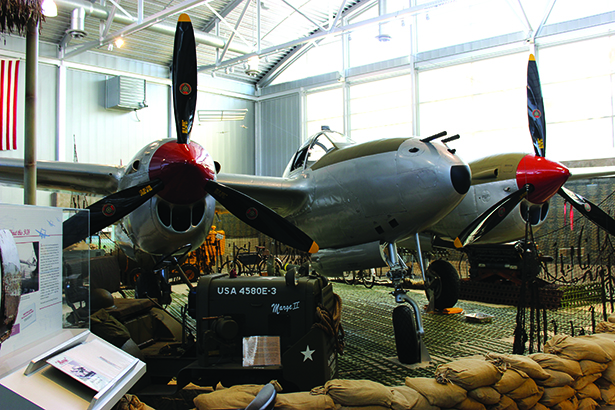
By Tony Bennett
New Programs and Events Spark Increased Visits to the Richard I. Bong Veterans Historical Center – and More Opportunities to Tell Veterans’ Stories
On August 7, 1945, there were two major headlines on the front page of the Los Angeles Times. The one at the very top read “ATOMIC BOMB HITS JAPAN” in the capital letters befitting such a monumental, historic event. The one just below that – in just a slightly smaller font – read “Jet Plane Explosion Kills Maj. Bong.”
On that day, the editors of one of the nation’s biggest newspapers clearly felt that the first use of nuclear weapons in human history was the most important message to get to readers. They also clearly felt that the death of one of America’s most decorated fighter pilots was also big news.
The “Maj. Bong” of the second headline was Major Richard Ira Bong, a flying ace who had downed more enemy aircraft in World War II than any other pilot and who had received the Congressional Medal of Honor for service to his country. Bong was also a Superiorite; he was born in the city and grew up on a farm in Poplar. In 1938, he studied at Superior State Teachers College (the forerunner of what became the University of Wisconsin-Superior). While at the college, he took private flying lessons and also enrolled in the Civilian Pilot Training Program. He subsequently enlisted in the Army Air Corps Aviation Cadet Program and later was commissioned a second lieutenant and awarded his pilot’s wings in 1942.
At 24, his life was cut short when the experimental jet plane he was piloting crashed in California – just six months after he married his sweetheart, Marjorie Vattendahl, in Superior. Thousands attended his funeral services in Superior.
Today, people in the Twin Ports drive back and forth from Superior and Duluth over the Richard I. Bong Memorial Bridge, and his military service as the highest-scoring American fighter pilot during the war that gradually became known as “The Big One” are known to many. Even people with no interest in history probably have some awareness of who Bong was, due to the fact that his name and story are part of local lore.
“These people who served – it’s not just their time in the military, but also what they did after the fact and how it kind of shaped the community as well.”
– Executive Director Hayes Scriven
A big part of the enduring legacy of the Bong story and name is due to the dedicated work of the staff and volunteers at the Richard I. Bong Veterans Historical Center in Superior, located at 305 Harbor View Parkway. Since 2002, the center has diligently worked to educate its visitors about the life and work of Bong and how his service to the country played a role in one of the deadliest wars in human history.
Now, though, as World War II vets lessen in number with every passing year, the center has crafted plans for the future that not only include educating visitors about Maj, Bong’s legacy and the conflict he flew in, but to also honor soldiers who’ve served in wars that America has been a part of over the decades. It’s a plan that means more inclusiveness and the opportunity to tell many, many more veterans’ stories through center programs and events.
Hayes Scriven is the center’s executive director and has been in that role for about a year. In the mid-2000s, he was a student at the University of Minnesota Duluth and served as an intern at the Center in his senior year. “I developed an exhibit on holidays during World War II,” he said. “It gave me my first taste of local history.”
After his graduation, Scriven went to Northfield, Minn., to take a job as director of the Northfield Historical Society, where he worked for more than 11 years. Then he received a phone call one day.
“A little over a year ago, I got a call from Dan Hartman, who runs Glensheen [Mansion in Duluth],” he said. “He told me that this job had opened up. He’d known that I was kind of itching to get back up to the Northern half of the state. I applied just to see what would happen.”
“If you can actually see her uniform and see her picture and imagine her in that situation, I think it makes it that much more powerful.”
– Curator Briana Fiandt
Of course, Scriven got the gig, and he moved his family to the area to begin a new chapter in his life. He was happy about getting “an opportunity to get in the community and learn about how history affected that community, and to try to present that history to people.”
Scriven says his executive director duties include a little bit of everything: “I oversee the day-to-day operations of the center, which means managing staff, fundraising, membership development, marketing, program development – anything and everything, really.
“The CliffsNotes version of the mission statement is that we’re here to honor and preserve Maj. Bong’s story and [that of] all veterans from World War II to the current day,” Scriven explained of the center’s reasons for being. “We tell all of their stories through exhibits and programs. My goal down the line would be to eliminate the starting point of World War II and just be an all-inclusive center for veterans, so we could go back and tell World War I stories or Civil War stories.”
In addition, Scriven says he’d like to see the stories about veterans’ post-service lives delved into more deeply. “These people who served – it’s not just their time in the military, but also what they did after the fact and how it kind of shaped the community as well,” he explained. “Everything you always hear is what they did while they were in the service. You never come to find out that they became a CEO of a Fortune 500 company or they ran a successful mom-and-pop bakery. You never hear that kind of story.” Scriven added that he’d also like to look into – and honor – the lives of vets who had less success, including those who suffered the effects of post-traumatic stress disorder for years afterward.
Indeed, there is a pivot that’s taking place at the Richard I. Bong Veterans Memorial Center, one that has already begun, and it’s something in which Scriven is deeply involved. “I come from the local history field,” he noted of his past work in Northfield. “I looked at history as a very big enterprise. Coming to a military museum, what I want to do a little bit is expand more. I want the Center to be seen as a community center, where people that have a general interest in amazing history and amazing stories can see how veterans in their community’s past have shaped what the community is today.”
“If kids don’t see a local face on it, it’s kind of far removed. Coming here, they … can touch things from that era.”
– Education Outreach Coordinator John Gidley
The center’s Research and Collections arm houses an impressive collection of more than 10,000 artifacts, personal letters and diaries, uniforms, photographs, newspapers and other documents in a state-of-the-art storage system with environmentally stable conditions.
And Briana Fiandt knows all about the historical treasures that are being carefully preserved there, since she is the curator at the center. Like Scriven, she also had the opportunity to spend some time at the center when she was younger, when she worked in the gift shop. Gradually, her life’s path led to her current role, in which she’s served for about four years. “I take care of all the collections,” Fiandt said of her job. “What you see in the museum is only a small percentage of our total collection. I make sure everything behind the scenes is cataloged and stored up to museum standards. I have a bunch of volunteers who work with me to help document everything.” When visitors tour the museum, the exhibits they see have been vetted and arranged largely by Fiandt.
Naturally, Fiandt selects the artifacts that help reflect the center’s mission. “We have a collection policy that determines what we take,” she explained. “Generally, what I’m looking for is a piece that has history. We do occasionally have people who will bring in something [artifacts] that they found in a garage sale or a thrift store, which is great. Those pieces generally end up in our education collection, because that’s something we use with school groups, and the kids can handle those materials. I want to give the visitor the chance to really engage with the exhibit on a personal level. I want them to hear an individual’s story.”
By way of example, Fiandt noted a World War I nurse’s uniform that is currently on display. “We’re telling the story of being in the trenches and getting gassed, and how awful the hospital situation was,” she said. “And if you can actually see her uniform and see her picture and imagine her in that situation, I think it makes it that much more powerful.”
Fiandt also noted that the P-38 Lightning airplane on display – the World War II-era piston engine fighter aircraft developed by Lockheed Martin for the U.S. Army Air Corps – is one of the biggest attractions. “It’s not one of the ones that Richard Bong actually flew, but it’s the centerpiece of the museum,” she said. Fittingly, the plane features an image of his wife and her name. Bong’s fighter plane was known worldwide as “The Marge,” since he had plastered her picture on the aircraft.
“We’re letting those veterans know we’re here and we’re available.”
– Board Member Ryan Kern
The pivot that’s taking place is proving to be an exciting challenge for Fiandt. “The bulk of our collection is World War II; that’s what we’ve been collecting for over 15 years,” she said. “But things have changed a lot since then. Oral histories are a huge part of what I do – and I think one of the most important. We record soldiers’ stories in their own words. And that’s definitely something we’re going to be using more of as we move into creating exhibits about some of the more recent conflicts.”
Education Outreach Coordinator John Gidley is focused on presenting the stories of local people who fought in America’s wars to young people touring the center. “In school, when you talk about World War II, it’s hard to put a local spin on it as a teacher,” he said. “If kids don’t see a local face on it, it’s kind of far removed. Coming here, they can see the stuff. They can touch things from that era. They can see video footage and get a great story, and that’s the important thing.”
The center features six primary exhibits: the Richard I. Bong Story and a new World War I exhibit as well as World War II, the Korean War, the Vietnam War and the Cold War. In addition to touring the exhibits, visitors can view short movies, stand in a replica control tower to view the P-38 plane on display, see a mock trench display and replica nuclear rocket, uniforms, photos, artifacts and so much more that helpsillustrate the experiences of military personnel.
For Gidley, it’s not just about talking sacrifice or focusing on heroism like Maj. Bong’s. It’s about presenting opportunities to people, young and old, for learning and reflection. “Our mission is to honor it [military service], so people can respect and appreciate what was done,” he said.
The staff serves as speakers at meetings or events, both on-site at the center and off-site. They also make presentations at local schools and meetings of nonprofit organizations and civic groups. Volunteer veterans share their experiences as well. In addition, custom programs can be tailored to meet needs. Students and their teachers can visit the center for a memorable educational experience that truly makes history come alive. And events like Camp Bong – where kids (accompanied by a parent or legal guardian) can see hands-on demonstrations of historic equipment and uniforms, participate in fun activities and games, enjoy pizza with veterans and then camp overnight right inside the Center – also help accomplish that objective. In addition, scores of students from throughout the region participate every year in the Center’s Middle School Essay Contest, in which three essay writers receive a $50 prize.
“We’re much more engaged from the marketing and public relations point of view than we were before.”
– Board President Terry Lundberg
Ryan Kern, the president of Kern and Kompany – the Duluth-based marketing and special events company that produces some of this region’s biggest events, including the Duluth Airshow – is on the Center’s board of directors. “There are a lot of commonalities between the work that we do with the Duluth Airshow and veterans support and outreach and the type of work that the Bong Veterans Center does,” Kern said. “It wasn’t a stretch for me to offer my services.”
Kern spoke of how satisfied he is with how plans and outreach have progressed. “Last December, we just did a huge outreach where we provided food to homeless veterans,” he said. “That’s not something the Bong Veterans Center had ever done before. We got creative. We brought in – no kidding – four tons of food. We’re letting those veterans know we’re here and we’re available; there’s a lot of resources we can offer to them. The all-encompassing mission is to be forward-thinking and then finding ways we can do that. That’s the key.
“We are trying our best to not just be a museum,” Kern said. “We want to be a social place. We want to be a meeting place. We really want to be community-oriented.”
These initiatives are definitely paying off. In 2017, paid admission at the museum increased by 1,627 over 2016 – the highest attendance increase ever. New events such as the Military Vehicle Show – presented last August by Kern and Kompany and featuring numerous vehicles and a boat from the Wisconsin National Guard and the Coast Guard – have been well attended. The center has either hosted or partnered for five special events since March of 2017, including a fun Saturday night Big Band Dance that featured music from a local high school jazz band and complimentary swing dancing lessons.
The staff and volunteers are also excited about two recent grants totaling $30,000. The first grant (of $20,000) will be used to upgrade the audio/visual equipment. The center will use a cash match gained at its annual fundraising auction to complete this project, since it will be used to contract local videographers to create new videos to tell veterans’ stories and create new videos.The second grant (of $10,000), awarded through the Duluth Superior Area Community Foundation, will expand youth programs. Through the creation of new “traveling trunks” that can be used by area schools, it will help create a Junior Curator Program in partnership with the Superior School District. It will engage 20 students entering eighth grade whose primary project will be to conduct oral histories with veterans and create a display for exhibition.
“The thing we advertise is that we have the best stories around.”
– Longtime Volunteer Debbie Ritzinger
Terry Lundberg, who chairs the board of directors, said there is a distinct sense of enthusiasm and progress. “With the addition of Hayes and John Gidley, we’ve come a long way,” he said. “We’re very happy with our staff. Briana has done a wonderful job with our collections and exhibits. Hayes has done a lot to increase our visibility; he’s adept at social media and marketing the enterprise. We’re much more engaged from the marketing and public relations point of view than we were before.”
Debbie Ritzinger is a longtime volunteer who deeply connects with the stories of people who fought on behalf of our country and to aid other countries. “The thing we advertise,” Ritzinger said, “is that we have the best stories around.” She recalled a young boy visiting the center with his grandparents who spent the entire day reading everything he could get his hands on. She’s clearly thrilled by that boy’s response. And that’s the great thing about the center. It’s a place where history is literally on display for people to see, hear and touch. It’s a place to feel the emotional impact of the victories, losses, courage and sacrifice of servicemen and servicewomen who have experienced the horrors of war. In other words, it’s much more than a museum. PS
Tony Bennett is a Twin Ports-based freelance writer.



